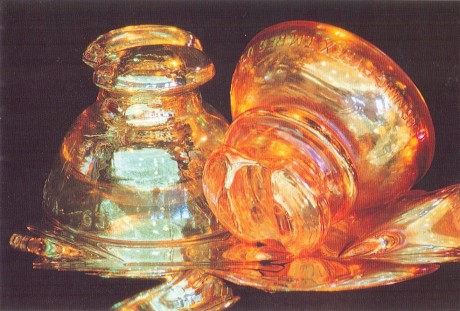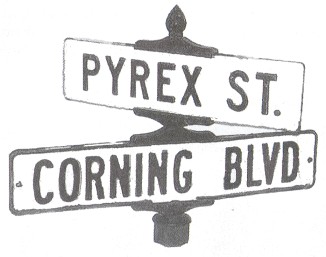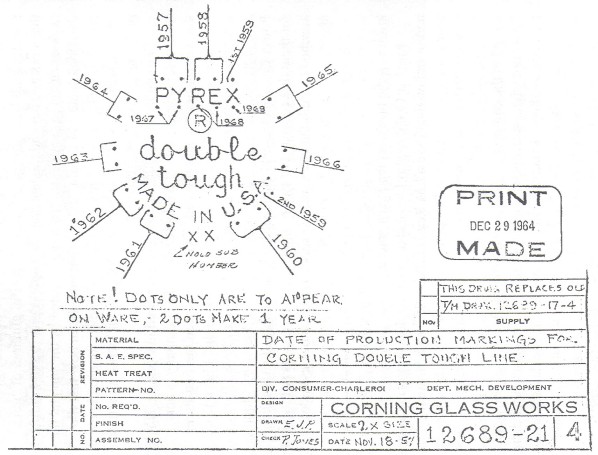Hey Dad! There's Gold On Them There Poles!!
by Greg Hafer
Reprinted from "Crown Jewels of the Wire", January 2000, page 6
The day started out to be just another typical Sunday for me. My family had
returned home from church and Mom was in the kitchen cleaning up after Sunday
dinner. The usual boredom was starting to set in for my brothers and me when Dad
suggested that we go hunting for insulators along a stretch of tracks between
Corning and Hornell, NY. I had no idea what surprise awaited me that afternoon
about 28 years ago. Unbeknownst to me, my Dad had already scoped this area out
and discovered that every pole had 2 Corning Pyrex carnival glass insulators on
it! Just like the ones pictured on this month's cover of Crown Jewels.
|

COVER: This month's cover is a photograph submitted by subscriber Jim
Stover of Plano, Texas.
"The photograph shows two Carnival Glass
insulators from my collection. I do not have a specialization but my
greatest interest is in beautiful color pieces.
I am an officer of the Plano Photography Club and took the
picture during a "Table Top Workshop" presented by the club. The
insulators were placed on reflective Mylar and surrounded by black velvet
material. They were illuminated using colored party lights. It took many
shots to get the arrangement and reflections just right. I am particularly
proud of the way the colors seem to flow like liquid from the insulators
and call the picture 'Liquid Gold'."
|
My Dad
was the catalyst that started me collecting insulators by bringing home some of
the larger Pyrex pieces from work. Dad was a lineman for New York State Electric
& Gas for 39 years. During his career he replaced the Pyrex pieces with
porcelain ones as the company upgraded their lines. I was in awe whenever he
would bring these home but when we drove out to the tracks that day and I saw
all
that glimmer on every pole for as far as I could see... well... that simply took
the cake! My Dad was and still is a class act in my book. He not only
"picked" every carnie that day but he also took the time to replace
the glass with a newer porcelain style. Now how many of you have gone to that
extent?? I suppose that would have looked better to the judge had the day gone
in that direction but thankfully it didn't. To make a long story (and afternoon)
short... we drove home that day with scads of carnies. Each one wrapped in its
very own protective wrap and nestled securely in Dad's stationwagon. What an addition to the family! What a day!! What a
Dad!!!

When Carol sent me a picture of this month's cover pic I realized that it
was the closest I could come to describing what I saw that day with Dad. Every
pole had a beautiful glimmer of "gold" that stretched beyond the
horizon. My only regret is that I didn't have a camera to capture the
"painting" created by the sun and the meshing of CD 234's and CD 235's
that day. Even now that the poles are long gone it is still a day that I will
never forget. I knew it was the perfect time to answer Carol's request and write
an article on Coming Pyrex insulators.
Corning Pyrex insulators were
manufactured in Corning, NY by the former Corning Glass Works (CGW). The company
is now known as Corning Incorporated. CGW introduced the first Pyrex insulator
in 1923 and based on an internal memo that I have from them the company stopped
insulator production in 1945. Pyrex insulators were first used on a high voltage
line owned by Montana Power Co.. An electrical engineer in charge designed an
insulator for them that consisted of two or more sleeve type units with a skirt
attached to a tubular sleeve which slipped over an oak cylinder about 2-1/2" in diameter by about 20" long. These were stacked with a regular
pin-type insulator at the top of the wood core. That is when the CD 248/311 was
born. As most of you know, this is known in the hobby as the Pyrex stacker.
Another CGW memo I have states that the dots appearing above and/or below the
"Pyrex T.M.Reg.U.S.Pat. Off." embossing is indeed the code system used
to identify the year of manufacture. It was wonderful to find this memo since
one of the biggest mysteries to me regarding the Pyrex insulators was what
purpose the dots served in the embossing. The only mystery left to solve now is
to figure out what years correspond to what "dot" embossing and there
are many of them. I keep my fingers crossed that one day somebody in the hobby
will find that engineering print that explains the dot/date code system in its
entirety. The following graphic is an engineer's print that shows the date codes
for the Pyrex "Double Tough" housewares line. Based on this print, I
would surmise that the same system is true for the insulator line.
Unfortunately, over the years, many of the documents that could answer these
questions have been lost or possibly destroyed in the 1972 flood (Agnes) that ravaged
Corning, New York.

During the early 1930's it was brought to the attention of CGW
engineers that there was a problem with electricity building up on the
insulators. This buildup would reach a peak and then discharge causing major
radio static that then made reception impossible. After many laboratory studies
by CGW it was found that coating the head of the insulator and the pinhole with
a so-called EC (electrically conducting) tin oxide could eliminate the
interference. This tin oxide coating was the same coating that was applied to
dishware given out at carnivals during the 1920's and 1930's. Hence, the name
"carnival glass" was used when describing these insulators that
"sported" the colorful tin oxide coating. I have seen the carnival
glass insulators in a variety of different colors. For the newer collectors, you
will find these in a deep orange coloring, a rainbow effect or a silvery/mirror
type look. They are all beautiful and can always find themselves a home within
the Hafer household.
I receive requests via Email from many people looking for
information on their Pyrex insulators. Requests for the value top the list but
following close behind are requests for the manufacturing dates of certain
pieces. With this in mind, I have noted below some of the manufacturing dates
that I am currently aware of.
|
1919
|
Pyrex glass patent issued On May 27, 1919
|
|
1922
|
Suspension insulators are
tested in New York
|
|
1923
|
CD 248/311 Stacker put to use by Montana Power Co.
|
|
1924
|
Radio / strain insulator production starts
|
|
1924
|
Suspension insulators are
offered for sale to American power companies
|
|
1926
|
CD 327 becomes the replacement
for the CD 248/311 stacker
|
|
1926
|
CD 240.5, CD 233, CD 235, CD 323, CD 325
|
1927
|
CD
240 & CD 322 Pyrex insulators now in use in 37 states
|
1930
|
CD 331
|
1932
|
CD
324, CD 326, CD 328, CD 328.2, CD 330
|
|
1941
|
Last year that Pyrex communication line insulators are manufactured
|
|
1945
|
Last year that Pyrex power line insulators are manufactured
|
|
1951
|
Last year that
Pyrex radio / strain insulators are manufactured
|
Many other inquiries that I receive during the year are those asking for
information about the Corning Museum of Glass. Corning Inc. has done a fantastic
job giving the museum a complete overhaul. I recommend a visit anytime you can
make the trip. You can write them at Corning Museum of Glass, 1 Museum Way,
Corning, NY 14830 or call them at (607)937-5371. For those with Internet access
you can contact them at http://www.cmog.org/mainpage.htm Another area of
the
Corning Museum of Glass that I highly recommend is the Rakow Research Library.
This has a wealth of information regarding glass. Unfortunately, the library is
quite limited as to what it can offer on insulators. This is a "must"
for those seeking information on glass in general. Their address is The Juliet
K. and Leonard S. Rakow Research Library, 1 Baron Steuben Place, 3rd Floor,
Corning, NY 14830-2253. The phone number is (607)974-8649 and the Fax number is
(607)974-8677. They can be reached via Email at Rakow@cmog.org The Library also
has an internet address of http://www.cmog.org/Library/index.htm.
I hope you
have enjoyed this article on Pyrex as much as I did writing it. I could fill
many more pages with Pyrex information and still have more information to pass
on. This article only touches on a few of the major points surrounding the
manufacture and use of Pyrex insulators. For further information please contact
me at Greg Hafer, 247 Dodge Ave., Corning, NY 14830 (607)936-8970. I also
welcome Email sent to Corningpyrex@prodigy.net.
While writing this article I had a
new collector Email me asking for information on Pyrex insulators. He was very
interested to learn that I was born and raised here in Corning, NY. I could
tell, through his return Email to me, that he was very excited to learn that I
still live here in Corning. He proceeded to ask me if I knew of any old dumping
sites where we might be able to get together and go on a "Pyrex dig". Interestingly enough, I do know of an old CGW dump
site. Every year when I till my garden the ground gives up a marble or two and I
can usually add a hunk of cullet to my daughter's glass collection. Yes, that's
right...the area of the Northside of Corning that I live in was an old CGW
dumping ground. I often wonder what may lie beneath the foundation of my home.
One of a kind prototypes entombed forever. Perhaps I should trade the tiller in
for a backhoe. Hey Dad! There might be gold in that there garden!! And so it
goes... may the Pyrex rest in peace.
| 